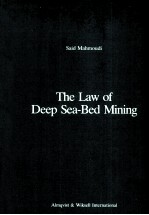图书介绍
THE LAW OF DEEP SEA-BED MININGPDF|Epub|txt|kindle电子书版本网盘下载

- 著
- 出版社: ALMQVIST & WIKSELL INTERNATIONAL
- ISBN:9122011560
- 出版时间:1987
- 标注页数:362页
- 文件大小:19MB
- 文件页数:364页
- 主题词:
PDF下载
下载说明
THE LAW OF DEEP SEA-BED MININGPDF格式电子书版下载
下载的文件为RAR压缩包。需要使用解压软件进行解压得到PDF格式图书。建议使用BT下载工具Free Download Manager进行下载,简称FDM(免费,没有广告,支持多平台)。本站资源全部打包为BT种子。所以需要使用专业的BT下载软件进行下载。如BitComet qBittorrent uTorrent等BT下载工具。迅雷目前由于本站不是热门资源。不推荐使用!后期资源热门了。安装了迅雷也可以迅雷进行下载!
(文件页数 要大于 标注页数,上中下等多册电子书除外)
注意:本站所有压缩包均有解压码: 点击下载压缩包解压工具
图书目录
Preface11
Abbreviations13
List of Cases15
PART ONE-Overview19
Chapter One-Preliminary Remarks19
1.1 General Introduction19
1.1.1 Presentation of the Problem19
1.1.2 The Purpose of the Study23
1.1.3 The Approach to the Problem24
1.2 Deep Sea-Bed and Its Mineral Resources26
1.2.1 Basic Facts27
1.2.2 The Economic Significance of the Deep Sea-Bed30
1.2.3 The Technology for Deepsea Mining31
1.2.4 The Actors33
1.3 The United Nations' Response36
1.3.1 The Sea-Bed Committee36
1.3.2 The Conference39
1.3.2.1 The Structure40
1.3.2.2 The Procedure42
1.3.2.3 The Progress of the Work45
1.3.3 The Convention48
Chapter Two-The Frontiers of the Deep Sea-Bed51
2.1 The Era of Coastal Claims to the Sea-Bed53
2.1.1 Background to the Claims before 194553
2.1.2 Truman Proclamations of 194555
2.1.3 The Work of the International Law Commission58
2.1.4 The United Nations Conferences in 1958 and 196060
2.1.5 North Sea Continental Shelf Cases63
2.2 The Era of Community Claims to the Sea-Bed65
2.2.1 The Sea-Bed Committee66
2.2.2 UNCLOS Ⅲ68
2.3 Article 7673
Appraisal79
PART TWO-The Legal Status of the Deep Sea-Bed85
Chapter Three-The Classical Bases of Claims to the Sea-Bed85
3.1 Claims of Rights Based on Res Nullius Concept87
3.2 Claims of Rights Based on Res Communis Concept and the Freedom of the High Seas103
3.3 Claims of Rights Based on Non-Prohibition in International Law112
Appraisal115
Chapter Four-The Principle of the Common Heritage of Mankind119
4.1 Developments During 1967-1970119
4.1.1 Malta's Proposal119
4.1.2 Reactions to Malta's Proposal121
4.1.3 The Content of Malta's Proposal and the Item before the Sea-Bed Committee122
4.1.4 Attitude of Different States about the Deep Sea-Bed at the Time of Submission of Malta's Proposal122
4.1.5 Malta and the Common Heritage of Mankind123
4.1.6 Opponents to the Common Heritage of Mankind124
4.1.7 Supporters of the Common Heritage of Mankind126
4.1.8 Moratorium Resolution130
4.2 Declaration of Principles132
4.2.1 The Long Way to the Compromise132
4.2.2 Adoption of the Declaration133
4.2.3 Declaration and the Question of the Legal Status of the Deep Sea-Bed134
4.2.4 The Binding Force of the Declaration140
4.3 Development of the Common Heritage Principle Since 1970149
4.3.1 An Encroachment to the Common Heritage:EEZ149
4.3.2 Developments inside the United Nations151
4.3.3 Developments outside the United Nations157
4.4 The Legal Status of the Deep Sea-Bed and the Convention164
Appraisal167
PART THREE-The Constituent Elements of the Legal Regime for the Deep Sea-Bed171
Chapter Five-Utilization System171
5.1 The Development of the Utilization System in the United Nations171
5.1.1 From Hopeful Optimism to Stalemate,1969-1976172
5.1.1.1 Utilization of the Area for Peaceful Purposes173
5.1.1.2 Utilization of the Resources for the Benefit of Mankind175
5.1.1.3 Initial Negotiating Positions178
5.1.1.4 Polarization of the Issue180
5.1.2 Towards a Compromise,1977-1980188
5.1.3 A Return to Disparity,1981-1982201
5.2 Utilization System in the Convention203
5.2.1 The Right of Access207
5.2.1.1 Technology Transfer209
5.2.1.2 Site-Banking Scheme211
5.2.1.3 Financial Undertakings211
5.2.2 The Balance of Rights215
5.2.2.1 Restrictive Measures215
5.2.2.2 Preferential Measures218
5.2.3 Viability of the Parallel System222
5.3 Utilization System outside the Convention225
5.3.1 General Features of National Legislation228
5.3.1.1 Definitions228
5.3.1.2 Declared Purposes229
5.3.1.3 Legal Bases230
5.3.2 Rights and Obligations under National Legislation233
5.3.2.1 Scope of Activities234
5.3.2.2 Temporal Scope235
5.3.2.3 Subjects of Law235
5.3.2.4 Qualifications of Applicants237
5.3.2.5 Size and Number of Mine Sites238
5.3.2.6 Similarities with the Provisions of the Convention238
5.3.2.7 Financial Terms239
5.3.3 National Legislation and Existing International Law242
Appraisal252
Chapter Six-Utilization Machinery255
6.1 The Need for an International Machinery256
6.2 The International Sea-Bed Authority266
6.2.1 The Status and General Features266
6.2.2 The Mandate and Functions267
6.2.2.1 Organizing Function267
6.2.2.2 Controlling Function268
6.2.2.3 Administering Function269
6.2.3 Organs of the Authority271
6.2.3.1 The Assembly272
6.2.3.2 The Council273
1.Composition274
2.Voting Procedure275
3.Organs278
4.Power Distribution between the Assembly and the Council280
6.2.3.3 The Enterprise283
6.2.3.4 The Secretariat286
6.3 Settlement of Disputes Relating to the Deepsea Mining287
6.3.1 Disputes Settlement System of the Convention287
6.3.1.1 Development of the System287
6.3.1.2 Types of Fora290
6.3.2 Disputes Relating to the Activities in the Area292
6.3.2.1 Institutions293
6.3.2.2 Scope of Jurisdiction294
1.Advisory Opinion294
2.Contentious Procedures295
6.3.2.3-Procedures and Applicable Law300
Appraisal302
PART FOUR-A View of the Future309
Chapter Seven-Interim Arrangements309
7.1 Features of the Preparatory Commission310
7.1.1 Purposes and Functions310
7.1.2 Organization311
7.1.3 Decision-Making311
7.2 Issues before the Commission313
7.2.1 Preparatory Investment Protection313
7.2.2 Establishment of the Authority and the Tribunal321
7.2.2.1 Rules of Procedure of the Organs of the Authority322
7.2.2.2 Developing Land-Based Producer States324
7.2.2.3 The Enterprise326
7.2.2.4 The Sea-Bed Mining Code329
7.2.2.5 The Law of the Sea Tribunal331
Appraisal333
Chapter Eight-General Conclusions335
Bibliography343
Index357